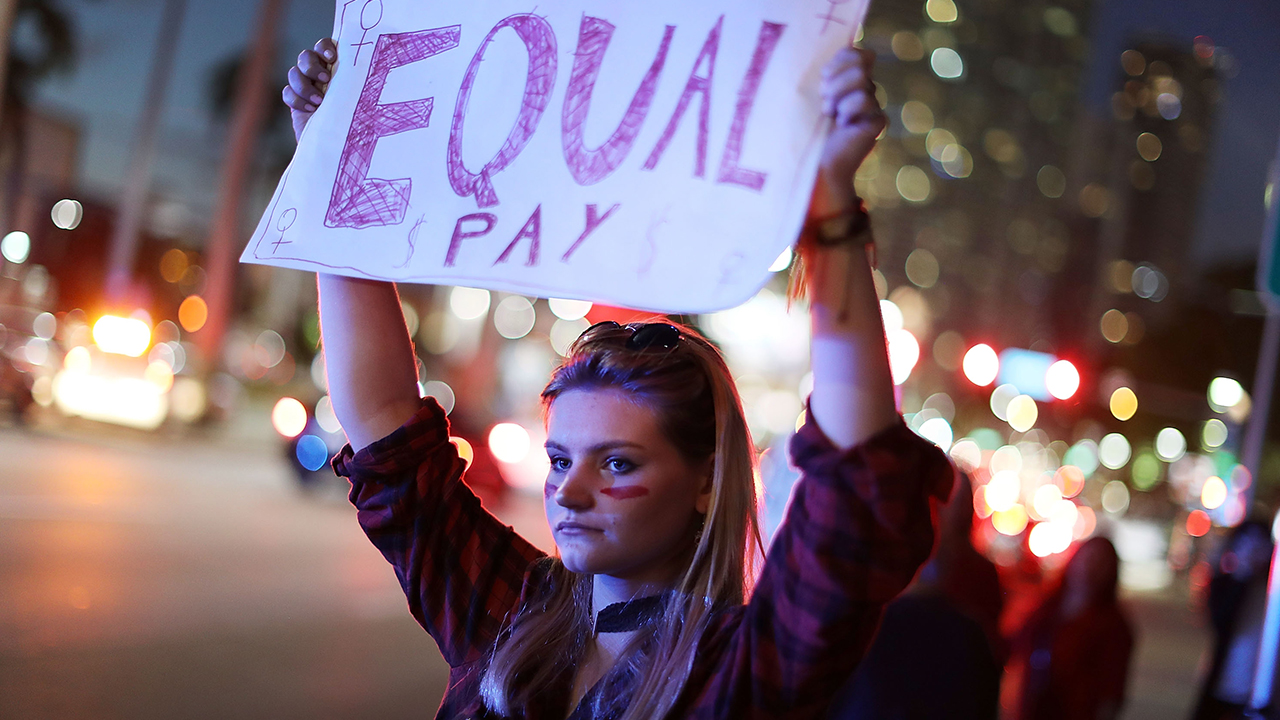
The Enduring Grip of the Gender Pay Gap
Table of Contents
The gender pay gap – the difference between the earnings of men and women – has barely closed in the United States in the past two decades. In 2022, American women typically earned 82 cents for every dollar earned by men. That was about the same as in 2002, when they earned 80 cents to the dollar. The slow pace at which the gender pay gap has narrowed this century contrasts sharply with the progress in the preceding two decades: In 1982, women earned just 65 cents to each dollar earned by men.

There is no single explanation for why progress toward narrowing the pay gap has all but stalled in the 21st century. Women generally begin their careers closer to wage parity with men, but they lose ground as they age and progress through their work lives, a pattern that has remained consistent over time. The pay gap persists even though women today are more likely than men to have graduated from college. In fact, the pay gap between college-educated women and men is not any narrower than the one between women and men who do not have a college degree. This points to the dominant role of other factors that still set women back or give men an advantage.
One of these factors is parenthood. Mothers ages 25 to 44 are less likely to be in the labor force than women of the same age who do not have children at home, and they tend to work fewer hours each week when employed. This can reduce the earnings of some mothers, although evidence suggests the effect is either modest overall or short-lived for many. On the other hand, fathers are more likely to be in the labor force – and to work more hours each week – than men without children at home. This is linked to an increase in the pay of fathers – a phenomenon referred to as the “fatherhood wage premium” – and tends to widen the gender pay gap.
Related: Gender pay gap in U.S. hasn’t changed much in two decades
Family needs can also influence the types of jobs women and men pursue, contributing to gender segregation across occupations. Differential treatment of women, including gender stereotypes and discrimination, may also play a role. And the gender wage gap varies widely by race and ethnicity.
Pew Research Center conducted this study to better understand how women’s pay compared with men’s pay in the U.S. in the economic aftermath of the COVID-19 outbreak.
The study is based on the analysis of monthly Current Population Survey (CPS) data from January 1982 to December 2022 monthly files (IPUMS). The CPS is the U.S. government’s official source for monthly estimates of unemployment. For a quarter of the sample each month, the CPS also records data on usual hourly earnings for hourly workers and usual weekly earnings and hours worked for other workers. In this report, monthly CPS files were combined to create annual files to boost sample sizes and to analyze the gender pay gap in greater detail.
The comparison between women’s and men’s pay is based on their median hourly earnings. For workers who are not hourly workers, hourly earnings were computed as the ratio of usual weekly earnings to usual weekly hours worked. The samples include employed workers ages 16 and older with positive earnings, working full time or part time, including those for whom earnings were imputed by the Census Bureau. Self-employed workers are excluded because their earnings are not recorded in the CPS.
The COVID-19 outbreak affected data collection efforts by the U.S. government in its surveys, especially in 2020 and 2021, limiting in-person data collection and affecting the response rate. It is possible that some measures of economic outcomes and how they vary across demographic groups are affected by these changes in data collection.
“Mothers” and “fathers” refer to women and men 16 and older who have an own child younger than 18 living in the household.
The U.S. labor force, used interchangeably with the workforce in this analysis, consists of people 16 and older who are either employed or actively looking for work.
White, Black and Asian workers include those who report being only one race and who are not Hispanic. Hispanics are of any race. Asian workers include Pacific Islanders. Other racial and ethnic groups are included in all totals but are not shown separately.
“High school graduate” refers to those who have a high school diploma or its equivalent, such as a General Education Development (GED) certificate, and those who had completed 12th grade, but their diploma status was unclear (those who had finished 12th grade but not received a diploma are excluded). “Some college” include workers with an associate degree and those who attended college but did not obtain a degree.
How the gender pay gap increases with age
Younger women – those ages 25 to 34 and early in their work lives – have edged closer to wage parity with men in recent years. Starting in 2007, their earnings have consistently stood at about 90 cents to the dollar or more compared with men of the same age. But even as pay parity might appear in reach for women at the start of their careers, the wage gap tends to increase as they age.

Consider, for example, women who were ages 25 to 34 in 2010. In that year, they earned 92% as much as men their age, compared with 83% for women overall. But by 2022, this group of women, now ages 37 to 46, earned only 84% as much as men of the same age. This pattern repeats itself for groups of women who were ages 25 to 34 in earlier years – say, 2005 or 2000 – and it may well be the future for women entering the workforce now.
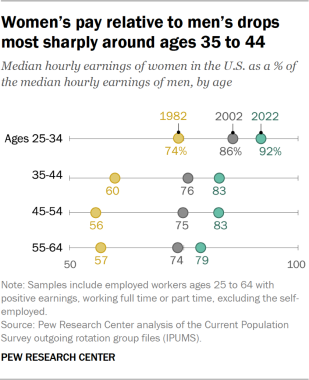
A good share of the increase in the gender pay gap takes place when women are between the ages of 35 and 44. In 2022, women ages 25 to 34 earned about 92% as much as men of the same ages, but women ages 35 to 44 and 45 to 54 earned 83% as much. The ratio dropped to 79% among those ages 55 to 64. This general pattern has not changed in at least four decades.
The increase in the pay gap coincides with the age at which women are more likely to have children under 18 at home. In 2022, 40% of employed women ages 25 to 34 had at least one child at home. The same was true for 66% of women ages 35 to 44 but for fewer – 39% – among women ages 45 to 54. Only 6% of employed women ages 55 to 64 had children at home in 2022.
Similarly, the share of employed men with children at home peaks between the ages of 35 to 44, standing at 58% in 2022. This is also when fathers tend to receive higher pay, even as the pay of employed mothers in same age group is unaffected.
Mothers with children at home tend to be less engaged with the workplace, while fathers are more active
Parenthood leads some women to put their careers on hold, whether by choice or necessity, but it has the opposite effect among men. In 2022, 70% of mothers ages 25 to 34 had a job or were looking for one, compared with 84% of women of the same age without children at home. This amounted to the withdrawal of 1.4 million younger mothers from the workforce. Moreover, when they are employed, younger mothers tend to put in a shorter workweek – by two hours per week, on average – than other women their age. Reduced engagement with the workplace among younger mothers is also a long-running phenomenon.
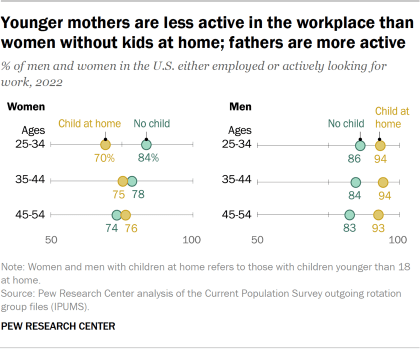
Fathers, however, are more likely to hold a job or be looking for one than men who don’t have children at home, and this is true throughout the prime of their working years, from ages 25 to 54. Among those who do have a job, fathers also work a bit more each week, on average, than men who do not have children at home.
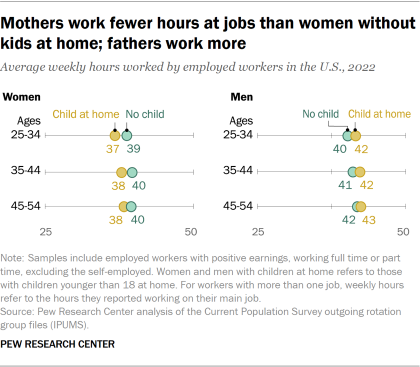
As a result, the gender gap in workplace activity is greater among those who have children at home than among those who do not. For example, among those ages 35 to 44, 94% of fathers are active in the workforce, compared with 75% of mothers – a gap of 19 percentage points. But among those with no children at home in this age group, 84% of men and 78% of women are active in the workforce – a gap of 6 points.
These patterns contribute to the gap in workplace activity between men and women overall. As of 2022, 68% of men ages 16 and older – with or without children at home – are either employed or seeking employment. That compares with 57% of women, a difference of 11 percentage points. This gap was as wide as 24 points in 1982, but it narrowed to 14 points by 2002. Men overall also worked about three hours more per week at a job than women in 2022, on average, down from a gap of about six hours per week in 1982.
Employed mothers earn about the same as similarly educated women without children at home; both groups earn less than fathers
Parenthood affects the hourly earnings of employed women and men in unexpected ways. While employed mothers overall appear to earn less than employed women without children at home, the gap is driven mainly by differences in educational attainment between the two groups. Among women with similar levels of education, there is little gap in the earnings of mothers and non-mothers. However, fathers earn more than other workers, including other men without children at home, regardless of education level. This phenomenon – known as the fatherhood wage premium – is one of the main ways that parenthood affects the gender pay gap among employed workers.
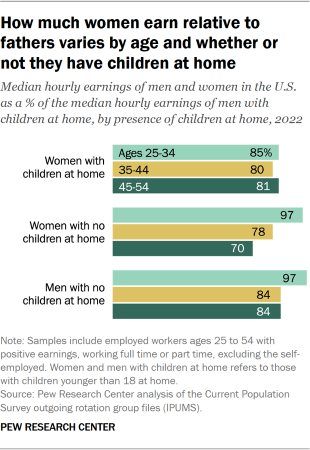
Motherhood does have important effects on the potential earnings of women. Women who experience breaks in their careers after becoming mothers sacrifice at least some of their earnings. Some mothers may never work for pay after having children, passing on earnings altogether. But it is difficult to know what the earnings of mothers might have been and, as a result, it is hard to know for certain what the full effect of motherhood is on women’s earnings. Estimates suggest that motherhood may account for much of the current shortfall in the earnings potential of women overall.1
Among employed men and women, the impact of parenting is felt most among those ages 25 to 54, when they are most likely to have children under 18 at home. In 2022, mothers ages 25 to 34 earned 85% as much as fathers that age, but women without children at home earned 97% as much as fathers. In contrast, employed women ages 35 to 44 – with or without children – both earned about 80% as much as fathers. The table turns for women ages 45 to 54, with mothers earning more than women with no children at home. Among those ages 35 to 44 or 45 to 54, men without children earned only 84% as much as fathers.
But these patterns in the earnings of employed mothers and women with no children at home are influenced greatly by differences in education levels between the two. Among employed women ages 25 to 34, some 61% of women without children at home had a bachelor’s degree or higher level of education in 2022, compared with 37% of mothers. It follows that among women ages 25 to 34, those without children at home (a more highly educated group, on average) earned more than women with at least one child at home. Conversely, employed mothers ages 45 to 54 were more likely than other women to have at least a bachelor’s degree – 58% vs. 42%. For that reason, mothers ages 45 to 54 earned more than women without children.2
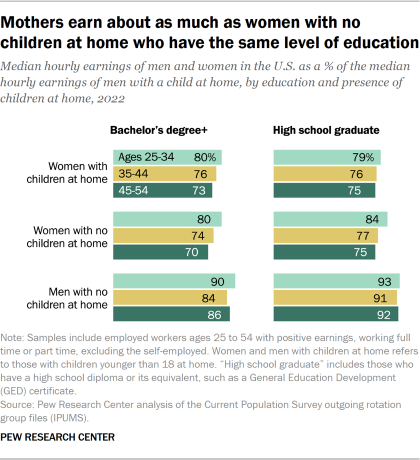
When the earnings of mothers are compared with those of women without children at home who have the same level of education, the differences either narrow or go away. Among employed women ages 25 to 34 with at least a bachelor’s degree, both mothers and women without children at home earned 80% as much as fathers in 2022. Among women ages 25 to 34 with a high school diploma and no further education, mothers earned 79% as much as fathers and women with no children at home earned 84% as much. The narrowing of the gap in earnings of mothers and women without children at home after controlling for education level also extends to other age groups.
Thus, among the employed, the effect of parenthood on the gender pay gap does not seem to be driven by a decrease in mothers’ earnings relative to women without children at home. Instead, the widening of the pay gap with parenthood appears to be driven more by an increase in the earnings of fathers. Fathers ages 25 to 54 not only earn more than mothers the same age, they also earn more than men with no children at home. Nonetheless, men without children at home still earn more than women with or without children at home.
Although there is little gap in the earnings of employed mothers and women with no children at home who have the same level of education, there is a lingering gap in workplace engagement between the two groups. Whether they had at least a bachelor’s degree or were high school graduates, mothers ages 25 to 34 are less likely to hold a job or be looking for one. Similarly, younger mothers on average work fewer hours than women without children at home each week, regardless of their education level. The opposite is true for fathers compared with men without children at home.
Progress in closing the gender pay gap has slowed despite gains in women’s education
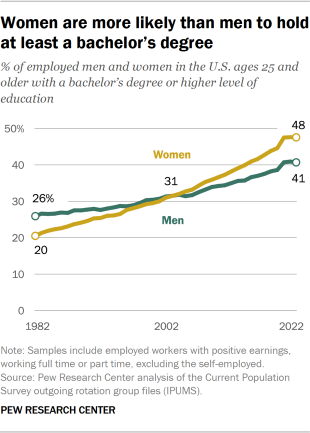
The share of women with at least a bachelor’s degree has increased steadily since 1982 – and faster than among men. In 1982, 20% of employed women ages 25 and older had a bachelor’s degree or higher level of education, compared with 26% of employed men. By 2022, 48% of employed women had at least a bachelor’s degree, compared with 41% of men. Still, women did not see the pay gap close to the same extent from 2002 to 2022 as they did from 1982 to 2002.
In part, this may be linked to how the gains from going to college have changed in recent decades, for women and men alike. The college wage premium – the boost in earnings workers get from a college degree – increased rapidly during the 1980s. But the rise in the premium slowed down over time and came to a halt around 2010. This likely reduced the relative growth in the earnings of women.
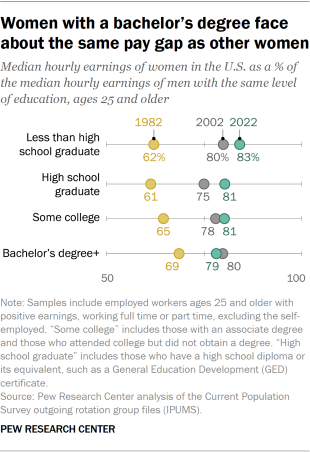
Although gains in education have raised the average earnings of women and have narrowed the gender pay gap overall, college-educated women are no closer to wage parity with their male counterparts than other women. In 2022, women with at least a bachelor’s degree earned 79% as much as men who were college graduates, and women who were high school graduates earned 81% as much as men with the same level of education. This underscores the challenges faced by women of all education levels in closing the pay gap.
Notably, the gender wage gap has closed more among workers without a four-year college degree than among those who do have a bachelor’s degree or more education. For example, the wage gap for women without a high school diploma narrowed from 62% in 1982 to 83% in 2022 relative to men at the same education level. But it closed only from 69% to 79% among bachelor’s degree holders over the same period. This is because only men with at least a bachelor’s degree experienced positive wage growth from 1982 to 2022; all other men saw their real wages decrease. Meanwhile, the real earnings of women increased regardless of their level of education.
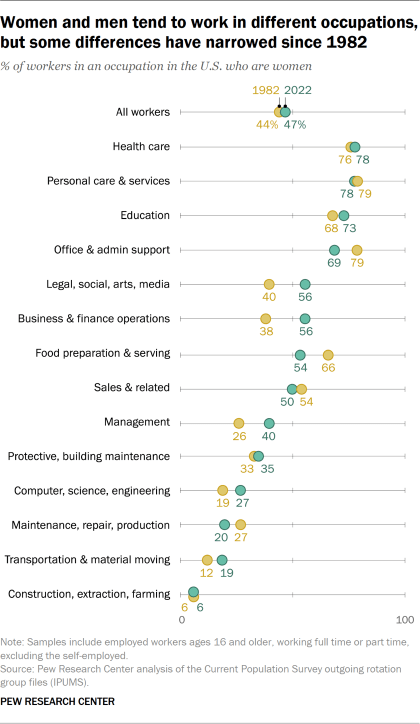
As women have improved their level of education in recent decades, they’ve also increased their share of employment in higher-paying occupations, such as managerial, business and finance, legal, and computer, science and engineering (STEM) occupations. In 1982, women accounted for only 26% of employment in managerial occupations. By 2022, their share had risen to 40%. Women also substantially increased their presence in social, arts and media occupations. Over the same period, the shares of women in several lower-paying fields, such as administrative support jobs and food preparation and serving occupations, fell significantly.
Even so, women are still underrepresented in managerial and STEM occupations – along with construction, repair and production, and transportation occupations – when compared with their share of employment overall. And there has been virtually no change in the degree to which women are overrepresented in education, health care, and personal care and services occupations – the last of which are lower paying than the average across all occupations. The distribution of women and men across occupations remains one of the drivers of the gender pay gap. But the degree to which this distribution is the result of personal choices or gender stereotypes is not entirely clear.
Gender pay gap differs widely by race and ethnicity
Looking across racial and ethnic groups, a wide gulf separates the earnings of Black and Hispanic women from the earnings of White men.3 In 2022, Black women earned 70% as much as White men and Hispanic women earned only 65% as much. The ratio for White women stood at 83%, about the same as the earnings gap overall, while Asian women were closer to parity with White men, making 93% as much.
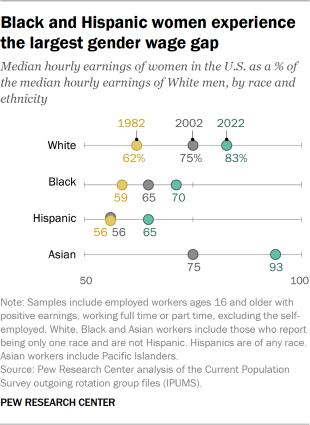
The pay gap narrowed for all groups of women from 1982 to 2022, but more so for White women than for Black and Hispanic women. The earnings gap for Asian women narrowed by about 17 percentage points from 2002 to 2022, but data for this group is not available for 1982.
To some extent, the gender wage gap varies by race and ethnicity because of differences in education, experience, occupation and other factors that drive the gender wage gap for women overall. But researchers have uncovered new evidence of hiring discrimination against various racial and ethnic groups, along with discrimination against other groups, such as LGBTQ and disabled workers. Discrimination in hiring may feed into differences in earnings by shutting out workers from opportunities.
Broader economic forces may impact men’s and women’s earnings in different ways
Changes in the gender pay gap are also shaped by economic factors that sometimes drive men’s and women’s earnings in distinctive ways. Because men and women tend to work in different types of jobs and industries, their earnings may respond differently to external pressures.
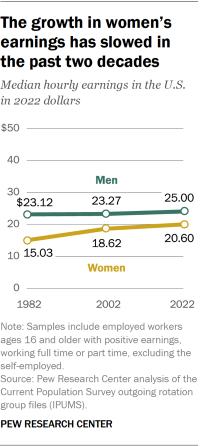
More specifically, men’s earnings essentially didn’t change from 1982 to 2002. Potential reasons for that include a more rapid decline in union membership among men, a shift away from jobs calling for more physical skills, and global competition that sharply reduced employment in manufacturing in the 1980s. At the same time, women’s earnings increased substantially as they raised their level of education and shifted toward higher-paying occupations.
But in some ways, the economic climate has proved less favorable for women this century. For reasons that are not entirely clear, women’s employment was slower to recover from the Great Recession of 2007-2009. More recently, the COVID-19 recession took on the moniker “she-cession” because of the pressure on jobs disproportionately held by women. Amid a broader slowdown in earnings growth from 2000 to 2015, the increase in women’s earnings from 2002 to 2022 was not much greater than the increase in men’s earnings, limiting the closure in the gender pay gap over the period.
What’s next for the gender pay gap?
Higher education, a shift to higher-paying occupations and more labor market experience have helped women narrow the gender pay gap since 1982. But even as women have continued to outpace men in educational attainment, the pay gap has been stuck in a holding pattern since 2002, ranging from 80 to 85 cents to the dollar.
More sustained progress in closing the pay gap may depend on deeper changes in societal and cultural norms and in workplace flexibility that affect how men and women balance their careers and family lives. Even in countries that have taken the lead in implementing family-friendly policies, such as Denmark, parenthood continues to drive a significant wedge in the earnings of men and women. New research suggests that family-friendly policies in the U.S. may be keeping the pay gap from closing. Gender stereotypes and discrimination, though difficult to quantify, also appear to be among the “last-mile” hurdles impeding further progress.



